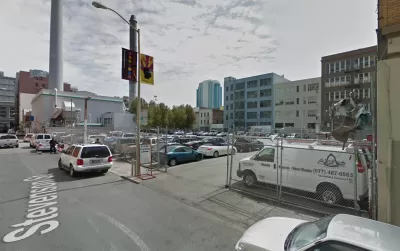A state court has ruled in favor of the San Francisco Board of Supervisors’ efforts to block a development project despite the state’s efforts to intervene.

California is in the midst of a singularly consequential experiment with state preemption and local control. Planetizen has been tracking the so-called “builder’s remedy,” which is designed to hold local governments accountable for failing to plan for enough housing development to accommodate the state’s population.
The most recent mainstream media attention to the builder’s remedy, an article by Liam Dillon published by the Los Angeles Times at the end of October, noted that the legality of the state’s new housing policy regime had yet to be contested in court.
Fast forward a few weeks and Chris Elmendorf, a law professor at the University of California, Davis who has positioned himself at the forefront of the development debate in California, writes that a state court recently delivered a blow to the state’s hopes of forcing local governments to plan for more development.
In a paywalled article for the San Francisco Chronicle, Elmendorf explains the court ruling regarding the “infamous 469 Stevenson project in San Francisco,” a project described in a recent paywalled article by J.K. Dineen as a “poster child for the insanity” of San Francisco housing politics.
“The developer seeks to replace a valet parking lot with 500 homes, many affordable, just one block from a BART station and in a priority development area as identified by the region’s climate plan,” writes Elmendorf.
A “neighborhood gadfly” convinced the San Francisco Board of Supervisors to reverse the approval for the project, according to Elmendorf’s telling of the episode, and demanded a development deal that would include analysis of potential gentrification effects of the project, while downsizing the project and donating some of the land on the parcel to the city.
“In response, Gov. Gavin Newsom’s housing enforcement team launched an investigation. It called the supes’ decision an ‘effective denial’ and warned that they may have violated the Housing Accountability Act, which says that cities generally can’t deny or downsize housing projects that comply with whatever rules are in place at the time the project application was submitted,” explains Elmendorf.
A recent ruling by a state court, however, throws out the state’s intervention.
“State housing laws, she ruled, do not apply to a project until after a city ‘certifies’ the project’s environmental review. Under the logic of this ruling, years may pass — or decades — and still the project proponents have no legal recourse — even if the city’s demands for additional study are frivolous, have nothing to do with the environment or constitute a transparent ruse to pressure the developer,” according to Elmendorf. “Although CEQA puts a one-year limit on environmental review, the court held that this deadline is just advisory and that courts have no authority to order a city to take any action on a project — or even to review the city’s demands — while the environmental review is ongoing.”
California State Senator Scott Wiener is quoted in the article comparing the “outrageous” decision to the ruling that almost forced the University of California, Berkeley to reduce enrollment by thousands due to a CEQA ruling by a state court. According to Elmemdorf, there is still a way forward for this development proposal, namely an appeal of the ruling. The builder’s remedy might require a new state law, modeled on AB 2656, written by planning think tank SPUR and Assembleymember Phil Ting, to inoculate itself from similar state rulings in the future.
FULL STORY: How San Francisco’s infamous 469 Stevenson project just helped gut California’s housing laws

Study: Maui’s Plan to Convert Vacation Rentals to Long-Term Housing Could Cause Nearly $1 Billion Economic Loss
The plan would reduce visitor accommodation by 25,% resulting in 1,900 jobs lost.

North Texas Transit Leaders Tout Benefits of TOD for Growing Region
At a summit focused on transit-oriented development, policymakers discussed how North Texas’ expanded light rail system can serve as a tool for economic growth.

Why Should We Subsidize Public Transportation?
Many public transit agencies face financial stress due to rising costs, declining fare revenue, and declining subsidies. Transit advocates must provide a strong business case for increasing public transit funding.

How to Make US Trains Faster
Changes to boarding platforms and a switch to electric trains could improve U.S. passenger rail service without the added cost of high-speed rail.

Columbia’s Revitalized ‘Loop’ Is a Hub for Local Entrepreneurs
A focus on small businesses is helping a commercial corridor in Columbia, Missouri thrive.

Invasive Insect Threatens Minnesota’s Ash Forests
The Emerald Ash Borer is a rapidly spreading invasive pest threatening Minnesota’s ash trees, and homeowners are encouraged to plant diverse replacement species, avoid moving ash firewood, and monitor for signs of infestation.
Urban Design for Planners 1: Software Tools
This six-course series explores essential urban design concepts using open source software and equips planners with the tools they need to participate fully in the urban design process.
Planning for Universal Design
Learn the tools for implementing Universal Design in planning regulations.
Ascent Environmental
Borough of Carlisle
Institute for Housing and Urban Development Studies (IHS)
City of Grandview
Harvard GSD Executive Education
Toledo-Lucas County Plan Commissions
Salt Lake City
NYU Wagner Graduate School of Public Service





























